Office Of Naval Research
-
- Ship Repair: Inside the $60m Refit of RV Roger Revelle Maritime Reporter, Jan 2021 #30
This month MR dives inside the $60 million refit of RV Roger Revelle, a project which leverages a treasure trove of ‘lessons learned’ from recent refits in the academic research vessel fleet and highlights the value of slimming the vendor list.
Research vessel (R/V) Roger Revelle is back at work after a midlife refit involving upgrades from top to bottom, bow to stern. The ship is owned by the Office of Naval Research and has been operated by Scripps Institution of Oceanography at the University of California San Diego since 1996. It is one of the largest ships in the U.S. Academic Research Fleet, an important asset to U.S. oceanographic research due to its range, payload, duration, and ability to safely conduct scientific operations in remote areas around the globe.
"Roger Revelle isn’t just revitalized, it is better than new,” said Bruce Appelgate, associate director and head of ship operations at Scripps Oceanography. “The midlife refit was an opportunity to apply everything we’ve learned about the ship since 1996, in order to make a great research vessel even more effective.”
The $60 million refit was supported by the Office of Naval Research (ONR), National Science Foundation (NSF), and UC San Diego, and highlights included:
- Repower: The repowering involved replacing the six existing air-cooled generators and split electrical bus configuration (auxiliary and propulsion separate) with four new water-cooled generators and an integrated bus (auxiliary and propulsion together). This included replacing major switchboards and transformers, as well as the propulsion motors and drives.
- BWMS: An Optimarin ballast water management system to help stop the spread of invasive species.
- Bow thruster: The installation of a new retractable ZF bow thruster to improve performance, vibration and noise.
- Cranes: An overhaul and replacement of overboard handling systems, with new cranes, a refurbished A-frame and hydrographic boom.
- Scientific Gear: The addition of a scientific instrumentation gondola.
Lessons learned
Ship design, construction and operation technology has changed mightily since RV Roger Revelle was delivered nearly a quarter of a century ago, and the team tasked to design, outfit and update the ship sought to use ‘lessons learned,’ both from the operation of the ship itself as well as experience from recent refits of other research vessels in the U.S. Academic Research fleet. A big factor in many of the refit decisions, in fact, were the shared experiences from the refit of the Thomas G. Thompson, operated by the University of Washington. “One of the great advantages that we’ve got at Scripps is being part of the community of ship operators in academic research fleet,” said Appelgate. “They shared everything with us, (including) their lessons learned.”One specific area was taking the decision to replace a noisy, inefficient bow thruster with a new retractable unit from ZF, a change which drops the bow thruster – and the related noise and vibration related to its operation – several feet beneath the hull, making living conditions on the ship more palatable and enhancing the collection of scientific data.
While Paul Mauricio, Port Engineer, and his team did extensive work to improve the efficiency and noise signature of the original bow thruster, including pulling, machining and fine-tuning the impeller on the water pumper, “It would max out at about 270 rpm, it would start to cavitate and it would shake the entire boat.” As Appelgate and his scientific colleagues will attest, external noise and vibration at sea is not a friend of good science, particularly as research ships like the RV Roger Revelle use the bow thruster for many hours and days at a stretch to stay on station while equipment is in the water.
With the new retractable bow thruster from ZF, “once it’s deployed, the noise is below the ship, not transmitted through the hull” said Mauricio. While the performance of the unit was critical, so too was being able to efficiently fit it into the ship, minimizing the level of modification work needed to get the new unit installed. “One of the driving factors to (which unit we picked) was the fact that it would fit in a retrofit without drastically modifying the entire bow,” said Mauricio.
While noise and vibration is bad for science, it’s equally bad for quality of life on any ship. “On Roger Revelle, up in the bow is where a bunch of our berthing quarters are located,” said Appelgate. “Typically that’s where the graduate students get put, so I was stuck up there (a few times). The reason you get ‘stuck up there’ is because it was noisy as heck because you were next to that (old) bow thruster. Even without cavitation, it was super loud. By installing the extendable bow thruster, it moves the source of noise farther away.”
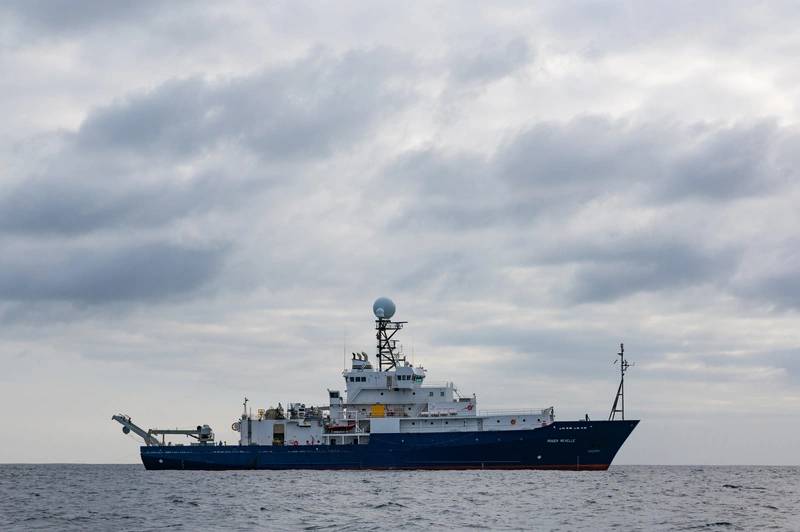 The R/V Roger Revelle pictured at sea for a 10-day commissioning and calibration cruise following its midlife refit. Photo Copyright: Scripps Institution of Oceanography
The R/V Roger Revelle pictured at sea for a 10-day commissioning and calibration cruise following its midlife refit. Photo Copyright: Scripps Institution of OceanographyBetter science, minus the bubbles
“I’m a geologist,” said Appelgate. “Back when I was doing research, my interest was in sea floor mapping,” and I sailed on the Roger Revelle as a scientist before I worked at Scripps. According to Appelgate, the configuration the ship’s mapping sonars when built in 1996 was “the worst place you could possibly pick on the ship for your mapping sonars.”“Ships like Roger Revelle are very broad and not super long; so it pitches a lot,” said Appelgate. “As it goes through the water pitching, it makes lots of bubbles and the bubbles sweep down along the hull. Bubble masking is something that we understand very well now, but not so much back in 1996. The place where all the transducers were (originally placed) were right in the place where bubbles would wash down and, basically, wipe out your sonar signals.”
“In the period since then, there’s been a lot of work done on how to mitigate that on a vessel without rebuilding the ship.”
The answer was a gondola that puts the transducers a few feet below the hull “on a big metal structure that looks like a hammer head shark. It allows the bubbles to stay up next to the hull while the transducers are below them.” While the gondola was a boon for the science, it was one of the major design and construction challenges in the project. “Building that and then reconfiguring all the cable runs and moving the sonars down onto that thing was a big deal,” said Appelgate.
“You know, the ship is the science,” said Appelgate. “I cut my teeth on making and operating sonars that were towed behind a ship. As we got better with sonars and motion sensors, those evolved into multi beams. Then we put them onto the ship. Now, all of a sudden, the ship is your sensor. I think it’s a valuable exercise to look at a ship holistically in that there’s an instrument on the ship, let’s say a multibeam, that’s only as good as everything that it’s attached to. Just like vibration, if you’re transmitting a bunch of mechanical sound into your sonars, you’re going to get junk. The ship is the instrument.”
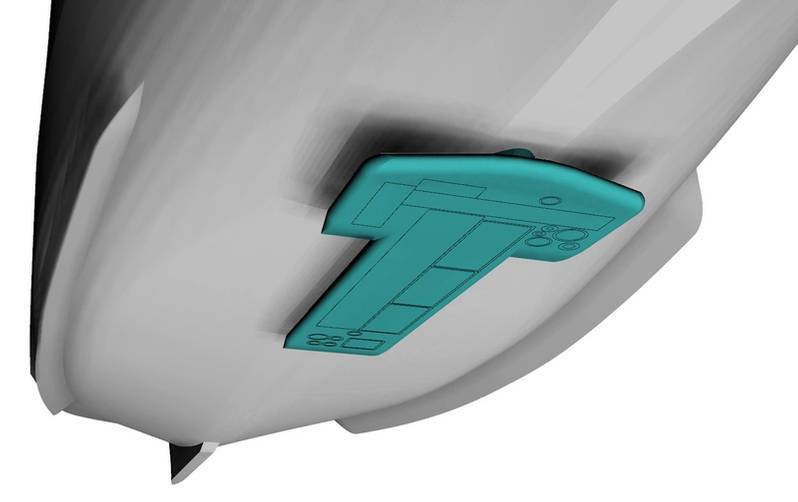
The answer to 'bubble masking' was the addition of a 'gondola' that puts the transducers a few feet below the hull on a big metal structure that looks like a hammer head shark. Image courtesy Glosten
Cleaner power
The original ship contract value was for $35 million to take care of specific ship systems – propulsion, controls, HVAC, piping, ballast water management – and steelwork to extend the life of the ship another 15 years or more, said Appelgate.But “we knew that other issues on the ship needed to be addressed, or the primary users of the vessel just wouldn’t be satisfied.” That’s where the upgrades to science systems came in, adding another $25 million to the project.
“The repower itself was intense,” said Mauricio. “We gutted the entire engine room and we pulled about six miles of cable, and we replaced about six miles of cable. There was not a square foot of that ship that wasn’t disturbed.”
“We ended up going with Caterpillars for our main engines, two 3516’s and two C32’s, running them at 1800 rpm,” said Mauricio. “We put 2100 KW generators on the 3516’s and 940 KW generators on the C32’s.” He said while the addition of the scientific gondola increased fuel consumption by about 4%, the efficiency of the new machinery made it break even.
“The biggest challenge with this project is the integration of all new and existing systems,” said Benton Strong, Vigor, the shipyard. “Nearly every major system was either replaced entirely or upgraded significantly, merging elements of new construction and ship repair into one cohesive project.” To streamline the flow of information among multiple parties, Vigor commissioned a custom document control system that allowed key partners to upload, review, comment and approve documents on a shared web based platform.”
“We made the mistake in the past by having different vendors supply equipment,” said Mauricio. “The integration is always difficult, and on a retrofit like this, it’s one of the biggest deals. It’s inevitable that if you have multiple vendors with multiple equipment there is always a problem, but it’s always ‘his problem, not mine.’”
To that end, according to Mauricio, minimizing the number of vendors and use COTS equipment was critical, as when the ship was built it included a broad diversity of equipment and manufacturers, which ultimately made the ship more difficult (and costly) to service. “Our goal here was to simplify everything in common off-the-shelf equipment,” and it was able to use experience building the RV Sally Ride five years ago to help in the process. “A lot of our choices were driven by that familiarity with vendors, our crew’s familiarity with equipment,” said Mauricio. “We felt that if the crew is more interchangeable and you’re familiar with equipment, we can keep our boats in better condition.”
A point of focus too, for all machinery was to mitigate noise and vibration. “We have learned a lot about power management and efficiency,” said Mauricio. “We incorporated all of that when we did the designs for the new propulsion systems. (Critical was keeping the vessel quiet as) Bruce’s sonars, their data, relies on the vessel being extremely quiet as far as noise transmitted through the hulls.”
To that end much time and effort was expended in the engineering phase to evaluate noise sources and devise means to mitigate. “Nothing makes direct contact with the hull; to sonars,” said Mauricio. In addition, Vigor partnered with Bruce S. Rosenblatt & Associates (BSR) to provide detailed engineering support of structural, mechanical and electrical systems. BSR used 3D modeling to develop detailed production level drawings suitable for material procurement and shop prefabrication. The 3D modeling process also helped identify design issues such as equipment and piping system clashes early in the design phase.
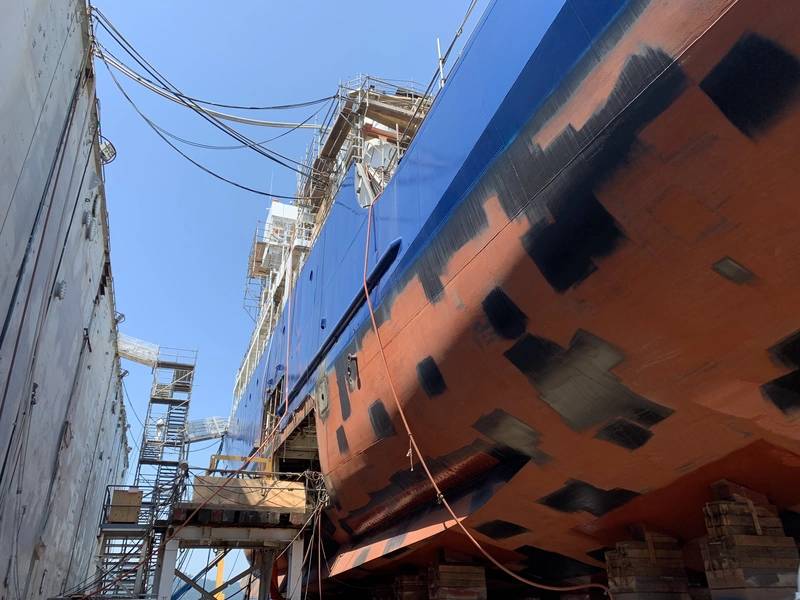 Engine room removal access. Image courtesy Glosten
Engine room removal access. Image courtesy Glosten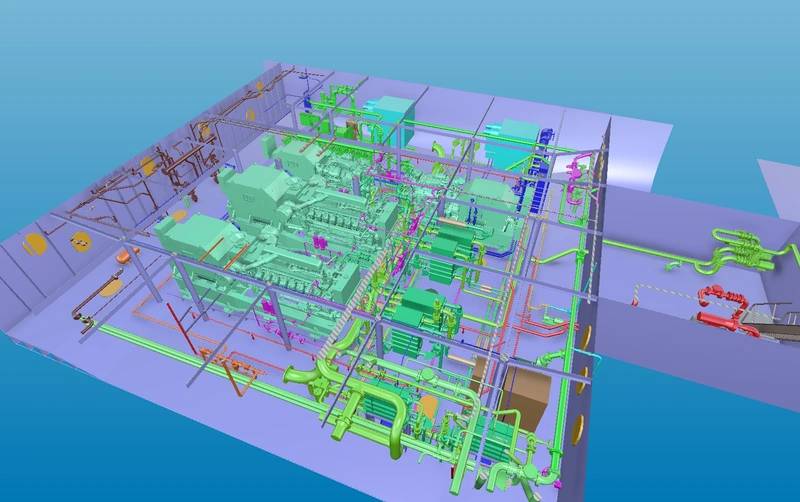 Cadmatic model of main engine room with new equipment. Image courtesy Glosten
Cadmatic model of main engine room with new equipment. Image courtesy GlostenAutonomy versus crewed ships
While there is a decided move towards increased use of autonomous systems in the ocean study space, Appelgate contends that there are still many jobs – particularly those that are far from shore and power intensive – that still demand a combination of crewed ships and autonomous systems.“The utility of unmanned systems is that you can achieve a persistence at sea that’s not possible with presence,” said Bruce Appelgate. “Unmanned systems that we’re deploying extend the ability of us to do our sensing at sea. It makes ships more useful.”
“Maybe in 50 years it will be different, but things like going to the southern ocean and doing CTE profiles, and the kind of hydrography that the big ships do routinely, you just can’t do it (with fully autonomous systems alone); you need too much power. Autonomy extends the utility of the service vessels. It makes us more efficient and gives us persistence.
The Network
Upgraded network capabilities support the significant amount of data collected from these instruments. A new virtual desktop infrastructure (VDI) includes display consoles for all systems throughout the ship, reducing the workload for scientists and crew members alike who use these during their operations. New cyberinfrastructure and centralized computer management helps the ship’s technicians maintain security and reliability of onboard computing and networking. “Something that has totally been fast tracked in the last nine months is our ability to use SATCOMs; we have realized the potential of SATCOMs in the academic research fleet in a way that we knew was possible, but there really hadn’t been the pressure to do it. In the midlife refit of Roger Revelle, Appelgate said “we completely rethought how we were going to do our cyber infrastructure on the ship.”“What we did with Roger Revelle is we reimagined and reengineered how that infrastructure could be configured in order that we could make the most advantage of existing SATCOMs, and anticipating things like these low earth orbit systems that would be coming out soon that will allow even higher bandwidth at lower cost in a broader geographic area.”
“We did a demonstration with Roger Revelle on sea trials, a test shot with a SATCOMs provider (where we) bumped up the internet connection on the ship to be equivalent to about what I experience at home. All of the sudden we went from a situation where you could barely get an email out to streaming video and real-time sending undecimated data sets, big data sets back to shore to be analyzed in near real time and returned to the ship. We’ve demonstrated that it can work, and it really is going to be a game changer for how U.S. scientific community does work at sea in the short term.”
The ship RV Roger Revelle
R/V Roger Revelle was put into service in 1996. It honors former Scripps Oceanography Director Roger Revelle who is widely regarded for not only establishing the institution as an internationally prominent science center, but for solidifying the decades-long relationship between Scripps Oceanography and the U.S. Navy.“Roger Revelle was a visionary who – back in 1946 – envisioned the Office of Naval Research as a world leader in sponsoring oceanographic basic research, and later foresaw the need for a new University of California in La Jolla that eventually grew around Scripps,” said Tom Drake, director of the Ocean Battlespace and Expeditionary Access department at the Office of Naval Research. “He also suggested the likely trajectory of the Earth’s climate, which we are now observing.”
Revelle served as an oceanographer for the U.S. Navy during World War II and was instrumental in the founding of the Office of Naval Research. Roger Revelle worked at Scripps Oceanography before and after the war and served as its director from 1950 to 1964. He was among the first to consider the implications of the accumulation of carbon dioxide in the atmosphere and absorption rates of the greenhouse gas by the ocean. A continuous profiling system under the ship will also measure carbon dioxide in seawater, an essential component of ocean acidification research.
The first research expedition on the all-new R/V Roger Revelle got underway in early November, an essential research mission led by UC Santa Barbara to retrieve ocean bottom seismometers measuring seismic activity and to collect rocks from seamounts and underwater volcanoes.
“The ship went down to about the Cook Islands where we recovered ocean bottom seismometers,” said Appelgate. “We retrieved 30 out of 30 of these ocean bottom seismometers, which is terrific as these things are worth half a million dollars each; the data on them are priceless. They had been up for a year and they were running out of batteries, so we had to go get them. It was a high priority cruise.”
The second research cruise began on Christmas day 2020.
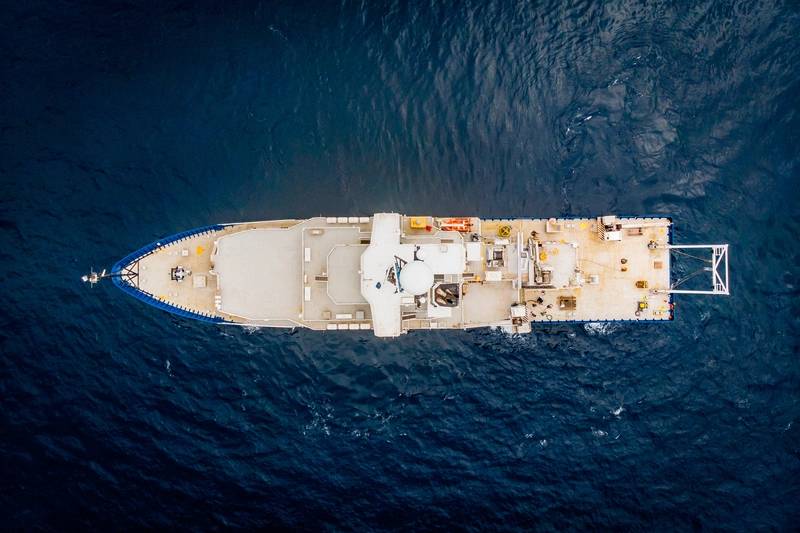 The R/V Roger Revelle pictured at sea for a 10-day commissioning and calibration cruise following its midlife refit.
The R/V Roger Revelle pictured at sea for a 10-day commissioning and calibration cruise following its midlife refit.
Photo Copyright: Scripps Institution of OceanographyRV Roger Revelle Refit ‘By the Numbers’
- Value: $60m
- Shipyard contract value: $43.8m
- Workers: 1,000 – including subcontractors and vendors.
- Duration: 14 months (April 15, 2019 – July 3, 2020).
- Cable: more than 21.75 miles of cable installed.
- Pipe: More than 3 miles of pipe installed.
-
- Inspired Youth Maritime Reporter, Jul 2013 #8
Rico convened at the IUPUI Natatorium for a weekend of competition and fun-filled activities. This Third National Challenge was sponsored by the Office of Naval Research (ONR), AUVSIFoundation and NAVAIR as well as ASNE, CISD, Indianapolis State Police Divers, Maritime Reporter, Mississippi State University
-
- MAJOR NAVY CONTRACTS Maritime Reporter, Sep 1986 #37
research. Work will be performed in Research Triangle Park, and is expected to be completed December 31, 1988. One bid was received. The Office of Naval Research, Arlington, Va., is the contracting activity (N00014-86-C-0460). Lockheed Missiles and Space Company, Austin Division, Austin, Texas,
-
- Subsea Defense: Navy Deepens Commitment to Underwater Vehicles Marine Technology, Jan 2021 #40
two different Large Displacement Unmanned Underwater Vehicle (LDUUV) concepts. An Innovative Naval Prototype LDUUV has been built by the Office of Naval Research. ONR’s INP is being used to evaluate software, autonomy, command and control, and integration of various payloads.Naval Undersea Warfare
-
- Predicting the Motion of the Ocean Maritime Reporter, Jul 2017 #34
introduced to industry at the 2017 Offshore Technology Conference in Houston. The approach, originally developed under funding from the U.S. Office of Naval Research, uses a custom-designed X-band radar to see waves up to 5 km from the ship or platform where it is installed. With specialized computer processing
-
- NRL Names Bradley New Superintendent, Acoustics Division Maritime Reporter, Nov 1985 #91
of the Chief of Naval Operations (OPNAV). From 1982 until he received his NRL appointment, he headed the Geophysical Sciences Division at the Office of Naval Research. Dr. Bradley holds a B.S. degree in physics from Michigan Technological University, a M.S. degree from Michigan State University, and
-
- Offerors For Operation Of Deep-Ocean Research Ships Sought By Navy Maritime Reporter, May 1991 #70
research community. Offerors may propose to operate either ship or both ships. Written requests for an RFP should be sent to the Office of Naval Research, 800 North Quincy Street, Arlington, Va. 22217-5000. For more information contact B. Hetfield at (703) 696-4513
-
- Cost-Saving Coating Approved Maritime Reporter, May 2000 #40
use of the coating will be as a replacement for hard chrome on a series of submarine components. The coating was developed under the Office of Naval Research (ONR) Science and Technology (S&T) Affordability Initiative and the DoD Dual Use S&T Program. The new coating is a nanostructured version
-
- Naval Hydrodynamics Symposium To Be Held At M.I.T. June 24-28 Maritime Reporter, Mar 1974 #4
year, the symposium is being sponsored by the U.S. Coast Guard and by M.I.T., in addition to the traditional sponsorship of the U.S. Navy Office of Naval Research. In keeping with the U.S. Coast Guard sponsorship, the dual theme of the symposium is (1) Hydrodynamics Problems Associated with Safety
-
- Titan to Develop and Build Navy X-Craft Maritime Reporter, Mar 2003 #15
The Titan Corporation has been awarded a $59.9 million contract by the U.S. Navy's Office of Naval Research (ONR) to develop and build the Navy's "X-Craft." The X-Craft will be a highspeed aluminum catamaran consisting of an advanced hull geometry, designed to give the craft speeds of 50 knots
-
- Int'l Symposium On Fracture Mechanics Proceedings Available Maritime Reporter, Aug 15, 1978 #19
Washington University, September 11- 13, 1978, will be available through the University Press of Virginia. This symposium, sponsored by the Office of Naval Research, presents an overview of fracture problems in ship and aircraft structures, as well as an international review of the state-of-the-art
-
- Sailing for Science Marine Technology, Jul 2013 #52
sense of where the fleet is today, and what the future holds. His report summarizes his conversations with the National Science Foundation (NSF); Office of Naval Research (ONR); National Oceanic and Atmospheric Administration (NOAA); and University of California-San Diego’s Scripps Institution of Oceanography
-
 )
March 2024 - Marine Technology Reporter page: 45
)
March 2024 - Marine Technology Reporter page: 45ronments. The new agreement will address speci? c techni- cal gaps in the UUV defense and offshore energy markets especially for long duration, multi-payload mission opera- tions where communications are often denied or restricted. As part of the new alliance, Metron’s Resilient Mission Autonomy portfolio
-
 )
March 2024 - Marine Technology Reporter page: 41
)
March 2024 - Marine Technology Reporter page: 41Image courtesy Outland Technology Image courtesy Exail Image courtesy Submaris and EvoLogics Vehicles The ROV-1500 from Outland Technology represents a leap forward in underwater robotics, a compact remotely operated vehicle (ROV) weighing in at less than 40 lbs (19kg) the ROV- 1500 is easy to transport
-
 )
March 2024 - Marine Technology Reporter page: 40
)
March 2024 - Marine Technology Reporter page: 40NEW TECH OCEANOLOGY INTERNATIONAL 2024 All photos courtesy MTR unless otherwise noted NEW TECH, PARTNERSHIPS LAUNCH IN LONDON With Oceanology International now one month in the rear-view mirror, MTR takes a look at some of the interesting technologies launched before, during and after the London event.
-
 )
March 2024 - Marine Technology Reporter page: 35
)
March 2024 - Marine Technology Reporter page: 35Figure 1 A self-righting vehicle design with buoyancy high and weight low, WHOI’s SeaBED AUV captures the attention of a pair of curious Antarctic penguins as it is deployed from the British research vessel James Clark Ross. Vehicle designers allowed for temperature reduction of battery capacity. Recharge
-
 )
March 2024 - Marine Technology Reporter page: 30
)
March 2024 - Marine Technology Reporter page: 30FEATURE SEABED MINING bilical. It has passive heave compensation which nulli? es the necott. “The focus since then has been on scaling while en- wave, current and vessel motions that in? uence loads in the suring the lightest environmental impact,” says The Metals power umbilical. The LARS can
-
 )
March 2024 - Marine Technology Reporter page: 29
)
March 2024 - Marine Technology Reporter page: 29n January, Norway said “yes” to sea- bed mining, adding its weight to the momentum that is likely to override the calls for a moratorium by over 20 countries and companies such as I Google, BMW, Volvo and Samsung. Those against mining aim to protect the unique and largely unknown ecology of the sea?
-
 )
March 2024 - Marine Technology Reporter page: 27
)
March 2024 - Marine Technology Reporter page: 27SEA-KIT USV Maxlimer returning from HT-HH caldera in Tonga. © SEA-KIT International data and further assess ecosystem recov- ery. What is known, noted Caplan-Auer- bach, is that the impact of submarine vol- canoes on humans is rare. “The HT-HH eruption was a tragedy, but it was very unusual. It let us
-
 )
March 2024 - Marine Technology Reporter page: 23
)
March 2024 - Marine Technology Reporter page: 23elatively inactive since 2014, the Hunga Tonga–Hunga Ha‘apai (HT-HH) submarine volcano began erupting on December 20, 2021, reaching peak intensity on January 15, 2022. This triggered tsunamis throughout the Pa- R ci? c, destroyed lives and infrastructure, and generated the largest explosion recorded
-
 )
March 2024 - Marine Technology Reporter page: 15
)
March 2024 - Marine Technology Reporter page: 15sensor options for longer mission periods. About the Author For glider users working in ? sheries and conservation, Shea Quinn is the Product Line Manager the Sentinel can run several high-energy passive and active of the Slocum Glider at Teledyne Webb acoustic sensors, on-board processing, and imaging
-
 )
March 2024 - Marine Technology Reporter page: 14
)
March 2024 - Marine Technology Reporter page: 14TECH FEATURE TELEDYNE SLOCUM GLIDERS to hold over 3.5 times as many lithium primary batteries as the the water column and its thrusters give it the ability to stay standard Slocum Glider, and to physically accommodate up to on track in strong currents or other dif? cult ocean condi- 8 different sensor
-
 )
March 2024 - Marine Technology Reporter page: 13
)
March 2024 - Marine Technology Reporter page: 13nyone familiar with glider hardware options integrated for a broad Glider answers that need,” said Shea autonomous underwater ve- range of missions. Quinn, Slocum Glider Product Line hicles (AUVs) is certainly “As the use of Slocum Gliders grew, Manager at TWR. A familiar with the popular- so did
-
 )
March 2024 - Marine Technology Reporter page: 12
)
March 2024 - Marine Technology Reporter page: 12TECH FEATURE TELEDYNE SLOCUM GLIDERS Teledyne Webb Research Engineers deploy the Slocum Sentinel Glider in Cape Cod Bay for testing. Teledyne Webb Research AS THE GLIDER COMMUNITY GROWS, SO DO GLIDERS By Shea Quinn, Slocum Glider Product Line Manager, Teledyne Marine 12 March/April 2024 MTR #3 (1-17).
-
 )
March 2024 - Marine Technology Reporter page: 11
)
March 2024 - Marine Technology Reporter page: 11assist in identifying mines and act as a neutralization device. About the Author Bottom mines pose even greater chal- David R. Strachan is a defense analyst and founder of lenges. Unlike contact mines, bottom Strikepod Systems, a research and strategic advisory mines utilize a range of sensors to
-
 )
March 2024 - Marine Technology Reporter page: 8
)
March 2024 - Marine Technology Reporter page: 8INSIGHTS SUBSEA DEFENSE Copyright RomanenkoAlexey/AdobeStock WHEN THE SHOOTING STOPS: BLACK SEA MINE CLEARANCE WILL FEATURE ADVANCED TECH, CONOPS By David Strachan, Senior Analyst, Strikepod Systems ince the beginning of the war in Ukraine, mine warfare mines have been the weapon of choice for both
-
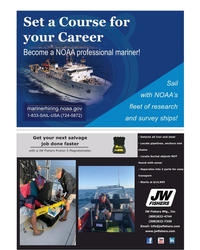 )
March 2024 - Marine Technology Reporter page: 7
)
March 2024 - Marine Technology Reporter page: 7Set a Course for your Career Become a NOAA professional mariner! Sail with NOAA’s fleet of research marinerhiring.noaa.gov 1-833-SAIL-USA (724-5872) and survey ships! - Detects all iron and steel Get your next salvage - Locate pipelines, anchors and job done faster chains with a JW Fishers
-
 )
March 2024 - Marine Technology Reporter page: 6
)
March 2024 - Marine Technology Reporter page: 6MTR Editorial Advisors Gallaudet Hardy The Honorable Tim Gallaudet, Kevin Hardy is President PhD, Rear Admiral, U.S. of Global Ocean Design, Navy (ret) is the CEO of creating components and Ocean STL Consulting and subsystems for unmanned host of The American Blue vehicles, following a career
-
 )
April 2024 - Maritime Reporter and Engineering News page: 48
)
April 2024 - Maritime Reporter and Engineering News page: 48Index page MR Apr2024:MN INDEX PAGE 4/5/2024 1:33 PM Page 1 ANCHORS & CHAINS MILITARY SONAR SYSTEMS tel:+44 (0) 1752 723330, [email protected] , www.siliconsensing.com Anchor Marine & Supply, INC., 6545 Lindbergh Houston, Massa Products Corporation, 280 Lincoln Street, SONAR TRANSDUCERS
-
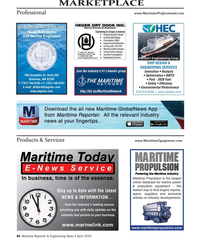 )
April 2024 - Maritime Reporter and Engineering News page: 46
)
April 2024 - Maritime Reporter and Engineering News page: 46MARKETPLACE Professional www.MaritimeProfessional.com GILBERT ASSOCIATES, INC.GILBERT ASSOCIATES, INC. Naval Architects and Marine Engineers SHIP DESIGN & ENGINEERING SERVICES Join the industry’s #1 Linkedin group )NNOVATION
-
 )
April 2024 - Maritime Reporter and Engineering News page: 43
)
April 2024 - Maritime Reporter and Engineering News page: 43“The industry is an ecosystem which includes owners, managers, mariners, shipyards, equipment makers, designers, research institutes and class societies: all of them are crucial,” – Eero Lehtovaara, Head of Regulatory & Public Affairs, ABB Marine & Ports All images courtesy ABB Marine and Ports provi
-
 )
April 2024 - Maritime Reporter and Engineering News page: 42
)
April 2024 - Maritime Reporter and Engineering News page: 42OPINION: The Final Word Seeing the Ship as a System Shipping must engage with the decarbonization realities that lie ahead by changing the way it crafts maritime legislation to re? ect its place in the interconnected, interdependent world economy, said Eero Lehtovaara, ABB Marine & Ports. ABB Marine &
-
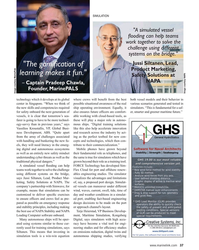 )
April 2024 - Maritime Reporter and Engineering News page: 37
)
April 2024 - Maritime Reporter and Engineering News page: 37SIMULATION "A simulated vessel ? ooding can help teams work together to solve the challenge using different systems on the bridge." – Jussi Siltanen, Lead, "The gami? cation of Product Marketing, learning makes it fun." Safety Solutions at NAPA – Captain Pradeep Chawla, Founder, MarinePALS Image
-
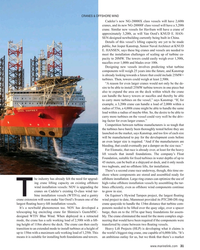 )
April 2024 - Maritime Reporter and Engineering News page: 31
)
April 2024 - Maritime Reporter and Engineering News page: 31CRANES & OFFSHORE WIND Cadeler’s new NG-20000X class vessels will have 2,600t cranes, and its new NG-20000F class vessel will have a 3,200t crane. Similar new vessels for Havfram will have a crane of approximately 3,200t, as will Van Oord’s KNUD E. HAN- SEN-designed newbuilding currently being built in
-
 )
April 2024 - Maritime Reporter and Engineering News page: 29
)
April 2024 - Maritime Reporter and Engineering News page: 29RADM PHILIP SOBECK, MILITARY SEALIFT COMMAND U.S. Navy photo by Bill Mesta/released U.S. Navy photo by Ryan Carter Rear Adm. Philip Sobeck, Commander, United States Navy’s Military Sealift Command, visits USNS Patuxent (T-AO 201) for a tour of the ship at Naval Station Norfolk, Va., November 20, 2023.
-
 )
April 2024 - Maritime Reporter and Engineering News page: 27
)
April 2024 - Maritime Reporter and Engineering News page: 27RADM PHILIP SOBECK, MILITARY SEALIFT COMMAND With COVID, we had to make some hard choices for our Do your CIVMARs have upward mobility? mariners because we couldn’t rotate. Many of our mariners The Navy has Sailors who become “Mustangs,” and work found other employment, and were able to use their skills
